In the 1950s, trucking magnate Malcom McLean changed the world when he got frustrated enough with the speed of trucking and traffic to start a commercial shipping company in order to move goods up and down the eastern seaboard a little faster. Within ten years, containers were standardized, and the first international container ship set sail in 1966. The cargo? Whisky for the U.S. and guns for Europe. What was once a slow and unreliable method of moving all kinds of whatever in barrels, bags, and boxes became a streamlined operation — one that now moves millions of identical containers full of unfathomable miscellany each year.
When I started writing this, there was a container ship stuck in the Suez canal that had been blocking it for days. Just like that, a vital passage became completely clogged, halting the shipping schedule of everything from oil and weapons to ESP8266 boards and high-waist jeans. The incident really highlights the fragility of the whole intermodal system and makes us wonder if anything will change.
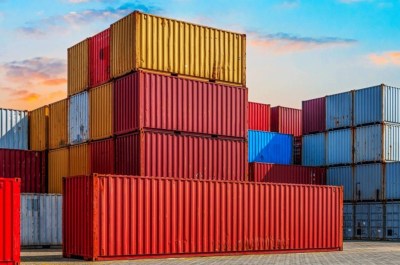
Setting the Standard
We are all used to seeing the standard shipping container that’s either a 10′, 20′, or 40′ long box made of steel or aluminum with doors on one end. These are by far the most common type, and are probably what come to mind whenever shipping containers are mentioned.
These are called dry storage containers, and per ISO container standards, they are all 8′ wide and 8′ 6″ tall. There are also ‘high cube’ containers that are a foot taller, but otherwise share the same dimensions. Many of these containers end up as some type of housing, either as stylish studios, post-disaster survivalist shelters, or construction site offices. As the pandemic wears on, they have become so much in demand that prices have surged in the last few months.
Although Malcom McLean did not invent container shipping, the strict containerization standards that followed in his wake prevent issues during stacking, shipping, and storing, and allow any container to be handled safely at any port in the world, or load onto any rail car with ease. Every bit of the container is standardized, from the dimensions to the way the container’s information is displayed on the end. At most, the difference between any two otherwise identical containers is the number, the paint job, and maybe a few millimeters in one dimension.
Standard as they may be, these containers don’t work for every type of cargo. There are quite a few more types of shipping containers out there that serve different needs. Let’s take a look at some of them, shall we?
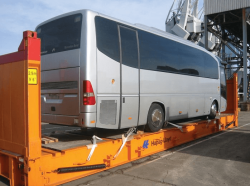
Flat Rack Container
Flat rack containers are basically platforms with no walls or roofs that are used to transport things like pipes, machinery, timber, buses, and boats. In other words, anything large or bulky that needs to be loaded and unloaded from the top.
Some flat rack containers have collapsible sides that make the cargo easy to remove, and others’ sides are fixed in place. Collapsible flat racks can be stacked together — a stack of four is about the size of a dry storage container. Flat racks come in both 20ft and 40ft sizes, though the widths and heights are often similar between the two.
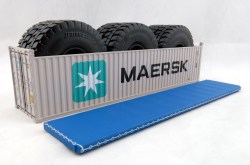
Open Top Container
There are a lot like dry storage containers, except they have either a tarp on the top or a convertible lid that can be taken off completely to accommodate shipments of any height, including massive tires.
The short sides double as doors, so there are a couple of options when it comes to loading and unloading cargo.
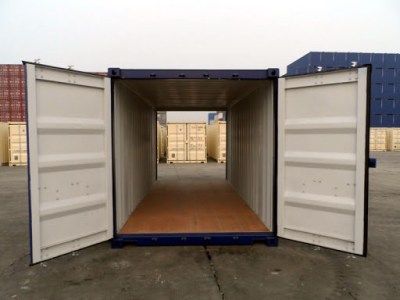
Tunnel Container
Also called double-door containers, tunnel containers are basically dry storage containers that open at both ends instead of just one. This makes it really easy to load and unload the shipment, or if the container is being used as a temporary warehouse, to get to a piece of stored cargo that would otherwise be stuck in the back of the container.
As you might expect, tunnel containers come in 20- and 40-foot lengths. They are usually made of steel and have plywood floors.
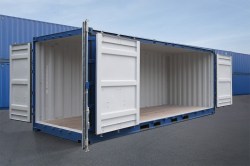
Open Side Storage Container
These are a lot like tunnel containers except that only one of the short sides has doors, and one of the long sides can be opened to accommodate wide things. This design is also useful for helping to locate specific cargo without having to unload too much of the container.
Many types of containers have forklift pockets so they can be easily moved around when empty. You can clearly see the forklift pockets around the bottom of this open side storage container.
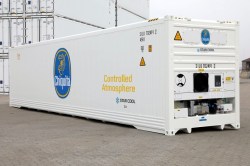
Refrigerated or “Reefer” Container
Reefer containers are used for shipping things like produce and other perishable items at consistent temperatures over long distances. They are typically air-cooled or water-cooled, though some of them come with a generator.
These containers are the reason that I can get oranges and apples year round, despite living in the Midwest. They’re also used for items like fresh flowers and pharmaceuticals.
The container pictured is designed to transport bananas, which must be kept away from oxygen lest they begin to ripen. It has a controlled atmosphere system that can keep bananas green for up to 45 days.
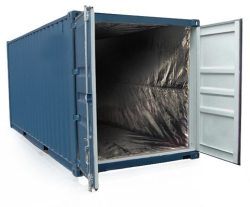
Insulated Container
Not all perishables have to be actively refrigerated during shipping, but they do need to be kept within a specific temperature range. Some things like apples or certain types of pharmaceuticals will do fine in an insulated or thermal container.
Insulated containers also serve the purpose of safeguarding the cargo from outside air contaminants by running it through a filter first. Some insulated containers have dual walls like a Thermos, and others are simply lined with thermal blankets.
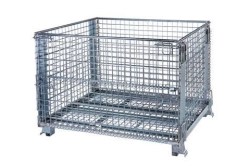
Cargo Storage Roll Container
These are specialized containers for transporting sets or stacks of things. They have rollers on the bottom that make them easier to move around, and the whole thing can fold up for storing and stacking.
Cargo storage roll containers are usually made from strong wire mesh and come in different colors.
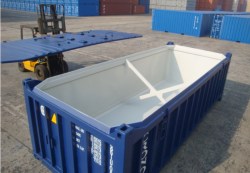
Half-Height Container
Half-height containers are basically dry storage containers that are half as tall, and can be either open-topped or closed.
These are usually used to move things like coal, stones, and other heavy, pour-able cargo that calls for easy loading and unloading. They’re also used for vehicles, heavy equipment, or anything else that fits inside. The lower center of gravity makes them quite useful for heavy loads.
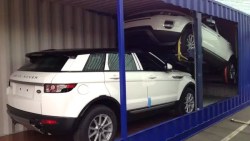
Car Carriers
Yep, you guessed it — these are for transporting cars and other vehicles. If you buy a car overseas, it has to get to you somehow.
Many car carriers have a ramp and two levels of racks so they can be stuffed with cars without wasting any space.
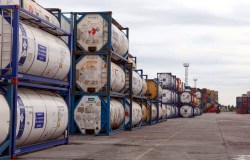
Tanks
Tank containers are giant steel cylindrical tanks with frames built around them. They’re used for shipping all kinds of liquids from molasses to gasoline.
Each tank container can carry 21,000 to 40,000 liters of whatever types of liquids it is designed to store.

Intermediate Bulk Containers
These are a class of specialized container that holds everything from liquids to solids. They are typically used for shipping goods like chemicals, food syrups, paints, and raw materials. IBCs are called intermediate because they are smaller than tanks but larger than drums.
Some containers are rigid, and others are flexible and fold up for storage when empty. IBC containers have only been around for about thirty years.

Drums
We’ve all seen these before, though there are many types beyond the 55-gallon drum. Drums are usually made from steel, hard plastic, or dense paperboard, depending on the intended use.
Drums are handy containers for many liquids and powders because they can be rolled, moved around with a hand truck, or stacked together on pallets for easily shifting groups of them around with a forklift.
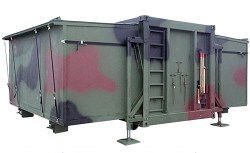
Special Purpose Containers
These are unique, sometimes one-off containers that are often used for high-profile shipments like weapons and military cargo. Because of this, they are often heavily secured.
Unlike most other standardized containers, these come in many shapes and sizes and are made of whatever materials suit the special purpose.

Swap Bodies
These are mostly used in Europe and have a strong bottom with the convertible top, so they can ship many kinds of items.
Swap body containers are typically only used on trucks and trains and don’t ride on container ships. Instead of a sturdy base with forklift pockets, these have spindly folding legs on the corners to support the container at a dock or between truck and train.
A Container for Everything
These are some of the most common types of shipping containers out there aside from the metal box we’re all familiar with. Lots of cargo has special needs, but it can all be containerized one way or another.
So what is it like to receive a large shipment via container ship? Our own [Bob Baddeley] has firsthand experience and told us all about it a while back. Do you have any experience with shipping at this scale, or have you ever repurposed a shipping container? Let us know in the comments!

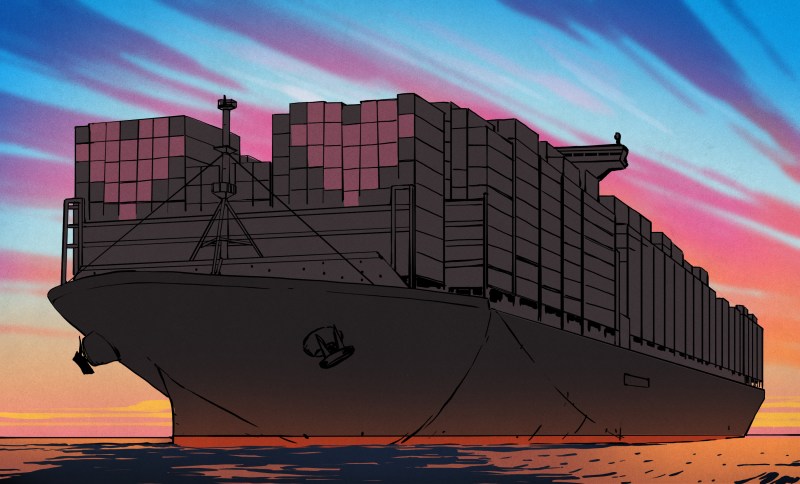













“The incident really highlights the fragility of the whole intermodal system and makes us wonder if anything will change.”
Plans for building alternate canals.
There’s also one use for containers not described. Video games. Those and crates and barrels.
Just build a new, wider Suez canal beside the old one (so it can keep working). It’s in the prefect location, which a canal is there in the first place.
Already the plan.
https://youtu.be/qIFzxM884jo
There WERE supposed to be 2 lanes, but SISI got spooked when he didn’t make any money from the 1/2 rebuild and only finished 1 lane.
build a new suez canal..why ?. mother nature fault ..no need to build a new canal ..
Mother nature got a lil fresh with a big container ship and stopped a huge fraction of global shipping for six days. Adding a second canal lane will not only give the canal redundancy but also increase throughput at one of the busiest and most important transcontinental shipping lanes in the world.
Back in the 1990s a study showed that improving/increasing the roads between points A and B…
Resulted in more people using the roads and no decrease in travel time.
“more people using the roads and no decrease in travel time”
Sounds like increased throughput to me.
If I want X items, and a shipping route can only handle a fraction of X, then my order must be spread over multiple trips.
Each trip takes Y days, and an extra canal will not change Y. BUT – the time between trips (call it Z) gets shorter.
It takes 12 – 16 hours to transit the canal, so 2 ships can be separated by at least that much time.
A 2nd channel reduces this, while offering redundancy.
Braess Paradox
I loved my Transportation Network Class
6″ tall?
Or did you mean 1828.8mm tall?
bad line break… 8′-6″ tall. 2591mm
Ah, thanks. 6′ tall didn’t seem right either.
Why not 259 cm?
Reefers with external cooling are today non-existent. They are replaced by self powered cooling systems from diesel/electrical powered cooling systems. Thats why some ships have lots of MWs electric power installed.
Fun fact I: pallets come in different sizes. Euro pallet, industrial pallet, container pallet and lots of other sizes. So it is a puzzle game to store them into a conti and not to waste any space.
Fun fact II: most ships can’t load “all full” contis. Take Ever Given, it has a about 200.000 tdw. But it can carry 10.062 40″ contis that can in theorie carry 306.703 tdw brutto (or so, depending what a tdw is).
Useless knowledge. :-)
Nice fun facts. A few more:
Loading these vessels is a LOT more complex that one might think (The group I work for does repair and repair logistics, so we primarily see the effect of doing it wrong)
There may be restrictions on where certain cargos can be loaded based on design or current state of the vessel. Cargo may be restricted based on limitations to or out-of-service firefighting gear, for example or stack may only allow heavys at the bottom for stability reasons.
Some cells under-hatch (in the holds) may be restricted for other reasons. The outboard cells may not allow heavies loaded first since the bottom supports sit on fuel tank roofs. Loading a heavy at the bottom of the cell may crack the plate (First box provides some cushioning as the next is set, as long as they aren’t dropped, but there will also be total weight limits. I’ve paid a LOT of bills doing flush patches here. Boxes get dropped)
Turn-loc’s (the pins for joining one box to the one above it above deck- twist-lock, stacking pin) are not cheap and the availability at a particular port can make a BIG difference in loading. Roll bins of these tend to move around a lot to make up supply. Nothing is more fun that sitting in port waiting for a chicken-cage of turn-loc’s to show up so the vessel being loaded can finish and get out of the way, so the one you are waiting for can get in. Repair crew paid to nap is a beautiful thing. Turn-loc’s are not light. They will leave a mark when knocked out overhead (rare, but it happens)
The container is fully supported by the corners, and only the corners. A stack with 10 or 12 units all in weight, but all loaded end heavy, can be a problem. They should, in a perfect world, be loaded balanced. The world is not perfect.
The load plan is done automatically in most cases, but not just for speed and economy. It is not practical on even a smaller vessel to do it manually anymore. The weights of the boxes are taken automatically, and balance may also be, when the boxes arrive at the port. Other considerations, like through cargo and the need to access a box under way also play in. NO ONE wants to pay to move a box out of the way.
Several years ago, we had a riding gang doing repair (the repair crew does the work while the vessel is underway) and one of the material boxes was not placed properly. I have no idea WHO paid, but I know how much it cost to basically dead-head a riding gang for about a week and pay penalty on time (client pays– we had other work scheduled).
I always marvel at how the ships are handled. I praise the people and crews that bring it all together…..
I do think some of the Ships are overloaded height wise, and I understand it has to do with distance and a bunch of other things..
My hat is off to you with much respect of your craft and skills.
Double quote, ” is the sign for inches. Single quote, ‘ is the sign for feet.
Useless knowledge: raise
Or better, in my opinion, stop using quotes for dimensions. Use “in” and “ft”, just like we use “cm” and “m”. So it would be 8 ft – 6 in container height. No confusion.
David St. Hubbins:
I do not, for one, think that the problem was that the band was down. I think that the problem *may* have been, that there was a Stonehenge monument on the stage that was in danger of being *crushed* by a *dwarf*. Alright? That tended to understate the hugeness of the object.
Ian Faith:
I really think you’re just making much too big a thing out of it.
Derek Smalls:
Making a big thing out of it would have been a good idea.
There ‘s too many cooling systems in your first paragraph for it to make sense ;)
Self contained cooling systems powered from external power or integrated diesel generator?
Both. Hybrid. Just as needed if there is electric power available or not. Most storage terminals won’t have electric power supply, some feeders don’t have it (or enough for hot days), some countries have lots of power outages (like USA). It’s an extra step to connect to electric power, so extra costs.
I assume that there are all sorts of variants for special cases like for regular shipment of frozen fish from A to B every week. And road reefers can be very different from shipping reefers. And there are flexible systems that allow to change/add/remove the cooling unit.
It’s total use case chaos so you wanne be flexible. Think of anything, I assume it exists. :-)
Not really my field of expertise. My boat had about 5,9 MVA electric power, I think it might need less than 1,5 MVA for itself, the remaining is for the reefers.
If you like this, be sure to read “The Box” by Marc Levinson. Excellent understanding of containers, the economics, and history!
The Ever Given incident didn’t so much highlight flaws in the intermodal system, but what happens when governments look the other way when presented with obviously unsafe conditions (I mean, a ship that is longer than the canal is wide and lacks sufficient power to overcome slightly-higher-than-average transverse winds, what else did they think was going to happen?).
Either the Egyptian government needs to get their ass in gear and pass some regulations or build an alternative method of shipping across their country, like building a cargo terminal at either side and a train loop to move containers between the two ports, or possibly tie into other rail systems so that Egypt becomes the final destination for ships, and its just trains from there on out.
I’m waiting for the official investigation, but will conjecture that winds were not the problem. If you searh for “bank effect” and “Hydrodynamic squat”, you may understand why I have doubts about the wind.
My bet is on C2H5OH.
When I went throu Panama Canal, first thing the pilot did was requesting a meal. Sorry, that is not the correct description: the cook was on stand by to serve her/him asap something top cuisine (that is a relative term) as soon as s/he put his behind onto the sofa. Pilot was distracted. Bribery is the name of the game.
Yes. Bridges have sofas. And fridges.
But when you go through a canal or in a port you often take on a pilot to drive the ship. A pilot is a local person who know the local space and rules and conventions who comes on board to drive the ship while in the port or canal. Panama and Suez canals do this. So it wasn’t the ship captain that ran it aground. Taking a meal break to eat right after the pilot comes on board makes sense.
You misunderstood what they said.
The captain didn’t take a meal break while the pilot is on board in that scenario. The pilot came on board, sat their ass down, ate a fine meal, and probably did little to nothing else.
Apparently Suez pilot teams are notorious for just going to their cabin and doing nothing for the duration of the transit.
The pilot doesn’t “drive the ship”. The regular crew operates, steers, etc. The pilot (in my limited dealings) provides direction. It is not unknown for a crew to ignore a pilot, not understand a pilot (NY harbour Jan2008, for example, with a helmsman that had poor command of english as one factor, the root cause being the ship’s master not informing the pilot of steering condition– a BRM [bridge resource management] issue, based on the model that has been used in commercial flight crew for a few decades with vast safety gains), or a pilot to treat the position as a sinecure, but these are the exception.
The pilot may not be expected to do much for most of the transit. There isn’t much going on, unlike NY harbour or the Mississippi river. I will guess that the blame will be firmly on the Master in the end.
I think it was a combination of both. In this video they mention that the wind force on the side of the ship was around 270t of pushing force. That’s equivalent to 3 harbour tugs pushing it sideways. As it was fighting against this force it oversteered and got close to the bank where the bank effect took hold and swung it into the bank.
https://www.youtube.com/watch?v=zf4qVJ65ghA
Excellent video animation of the incident! Thank You for sharing.
It is somewhat interesting how a lot of the freight going through the Suez canal could just take the train instead.
Or rather, “could someday just take the train instead.” Currently, the routes are a bit of a nightmare and far from ideal even on a good day. The trans Siberian railways is the “best” option, but it is a fair bit of a bottleneck in most cases.
Though, the Suez canal should also see about trenching out some more even depth, build a second lane for the whole channel, and likely look into not having traffic during sand storms with 70+ km/h winds and poor visibility….
The adage “Never underestimate the bandwidth of a station wagon full of tapes hurtling down the highway.” comes to mind.
Using some numbers from above, the Ever Given could hold 20,000 40 foot containers. End to end, that is 150 miles of containers. A train might be able to double stack them, but some spacing is required, so that could be 80 miles of containers. A straight line from Suez to Port Said is around 90 miles, the canal is 120 miles long. You’d expect a rail line to be similar. Multiply by 50 ships a day, albeit smaller. 500,000 containers a day? Seems unlikely but I can’t see a train system dealing with that much traffic. (Sorry for imperial units, but a container _IS_ 40 feet long. 5 miles is essentially 8 kilometers for this exercise.)
However, if the logistics were really good, container sorting could be performed, moving each container to a ship that most closely sails to the container’s destination.
Then there is cost and time. No way would ship to rail to ship be faster, meaning it would also cost more.
Finally, how would the energy efficiency compare? A train is slightly more energy efficient than a cargo ship, but that won’t make up for energy cost of transferring cargo to trains and back to ships again.
My conclusion? Rail will never replace the Suez canal.
A final thought – if you build a bigger canal, they’ll build bigger ships to fill it.
My statement were though not about a ship to rail to ship link between Suez and the Mediterranean sea.
I rather stated the fact that a rail link from eastern Asia to Europe could theoretically be a thing. Making the need for a ship largely redundant to begin with. But for such a rail link to be feasible then it needs a fair few of the countries along the route to not have current problems.
A double track railway allowing trains at 60 km/h could carry about 1-1.5 TEU a second on average while allowing for a sub 40% duty cycle between trains. This equates to about 3 to 4.5 million TEU annually in each direction. Not to mention a reduced transport time from current weeks down to 2-3 days if we have few stops along the route, but realistically it would likely approach a week, crew swaps, car shuffling and such fun stuff.
As a comparison point, The Ever given has a capacity of 20 124 TEU, or 10 062 Forty foot containers. (yes, the 20 foot containers is the standard measurement of capacity.) So our double track rail link could theoretically move 187 Ever Givens worth of cargo annually, a fair portion of global trade. Though, large container ships tends to stop along their journey, but that our train will likely need to do as well.
Considering the advantage in speed, but also the advantage of cleaner energy sources if one runs electric locomotives, then it has rather major benefits compared to ships.
Obvious downside is though to construct a railway for this distance.
Though, a casual look at open railway map indicates the existence of multiple rail links. Though, the only fully connected ones go through Russia and Kazakhstan, and they use the Russian gauge of 1 524 mm (5 ft) instead of the standard gauge of 1 435 mm (4 ft 8 1⁄2 in), so reloading will be needed, extra cost that ships don’t really have. Or ships do have such issues, all though it is up to the relevant officer on the ship to plan their stacks to minimize this issue.
But there is no reason that this route can’t in the future build a standard gauge section for this link making reloading unneeded. There is though political issues as far as sending freight through Russia, considering that they politically aren’t having “ideal” relations with western Europe.
Another link would be via Turkey, Iran, Afghanistan or Pakistan, via the disputed Kashmir region up to the also somewhat disputed south western China (aka Tibet). In short, this route is a bit politically unstable to be a viable investment.
A rail link is possible from a pure engineering and logistical standpoint. And from an environmental standpoint it is fairly good as well. And it to a degree already exists.
But from a political and bureaucratic standpoint, it isn’t currently an all that viable investment.
Ships going over international waters on the other hand doesn’t have to worry too much about anything of this. Other than pirates, disputed coast lines, and the occasional storm.
There is a train who takes from china to spain and the time it takes to do the travel is 16 days for 13000km because the different types of railways and trains but the company has doubled the number of trains last year (1000 Trains with 70000 teu)
Aren’t electric trains powered by diesel generators? There goes your clean energy.
Only if they can’t be powered through an overhead pantograph or “third rail” system.
If they can, the energy is as clean as the nearest power station.
There is a difference between diesel electric locomotives and electric locomotives.
The prior is a diesel generator running an electric traction motor. (since electric traction gives far better power efficiency at low RPMs. And is still fairly good at usual running speeds.)
The later is an electric traction motor that does not have any on board power source. Needing a third rail or overhead power line for it to run. Where the external energy source is usually some power station somewhere or another, can be solar, wind, hydroelectric, bio gas, natural gas, coal, nuclear or other options.
Then there is diesel locomotives that have no traction motors. And instead rely on a regular old transmission. These are though rare since they have higher wear compared to the alternatives using electric traction. (Getting a heavy train to start rolling is a lot of energy needed to be put through our clutch. Even if we use other methods of easing that burden, like having intentional slack between our rolling stock.)
35 trains per week: https://www.duisport.de/kompetenzen/logistische-dienstleistungen/chinaverkehr/?lang=en
There is no obvious advantage to doing this cargo transport by rail. It’s not actually “greener” per ton of cargo transported, it’s not actually more reliable (trains also have issues. Derailments, broken couplers, bearings running hot, locomotive breakdowns, etc).
Just because we now found a problem in one bottleneck doesn’t invalidate the usefulness of container ships.
“So our double track rail link could theoretically move 187 Ever Givens worth of cargo annually, a fair portion of global trade. ”
uhmm, no. 187 Ever Givens worth of cargo is an absolute pittance of a sliver of global trade. It might amount to a small portion if we look at just Intermodal Container cargo, but if you then take into account all the other types of cargo ships that ALSO sail those routes it becomes an absolutely insignificant amount. In 2020 the port of Rotterdam ALONE handled a bit over 14 million TEU. So the rail link couldn’t even handle a third of the annual throughput of Rotterdam in a BAD year! And thats JUST the containers and ignores the 185 million metric ton of liquid, dry and break bulk cargo carried by ships sailing to and from Rotterdam.
An advantage doesn’t have to be obvious for it to be an advantage.
But having a better rail link across Eurasia is beneficial both in regards to redundancy, but also some better expediency compared to ships while still not having the far greater costs of air transport.
In regards to it being greener, yes one can look at diesel locomotives and say that they aren’t much better than ships, and true, they aren’t. But electric locomotives tends to have better overall power efficiency, and external power plants tends to be easier to ensure that they are clean, not to mention that they too are more efficient. How the electrification of the route is implemented is though a different question.
In regards to “187 Ever Givens worth of cargo is an absolute pittance of a sliver of global trade.” depends on how one looks. A “fair portion of global trade” needs to be regarded in a relative sense.
No single transport route in the whole world could ever reach even 1% of global trade. Since global trade is spread out across the whole world. One can make an exception to the Zhujiang river estuary, but other than that, no other place comes close.
We rather need to look at a selection of routes of interest. For an example, ships going from China to LA won’t ever touch the Suez canal. Nor would it ever need our rail link either. A ship heading to Amsterdam or London is a different story. In short, everything that is irrelevant needs to be excluded. I can though accept that I likely shouldn’t’ have used to words “global trade”.
Not to mention that a fair portion is fairly ambiguity in itself. It doesn’t have to be 50+% or even 10+%.
In regards to other types of goods being transported, trains can carry a fairly sizable array or products. All though a bit more limited than some ships.
Yes, everything can’t take the train, for various reasons.
But it does offer advantages that ships doesn’t have, mainly noticeably faster transport while still being in the same pallpark in terms of costs that ships are.
Some times are though more expensive to move by train, either due to physical size, or other loading constraints. Some bulk cargo is cheaper by boat due to the ease of loading and unloading alone.
For an example, loading up 100’s of train cars with grain, coal, or other cargo isn’t trivial, especially if we want to minimize spillage.
Same goes for liquid products not to mention gas. A tanker ship one can just hook up 1 large hose to and wait, while a train involves a lot more labor and a lot less waiting. Though yes, a ship tends to have more than just 1 hose, but far from loading up the equivalent amount of train cars individually. Running a pipe between cars does work, but has its own downsides making it impractical.
But for ISO containers, the difference between train or ship is far from a major one.
Ships though have advantages in regards to crossing oceans, tend to have far larger limits in terms of size of cargo, and also tends to avoid a lot of boarders, reducing taxes/tariffs, not to mention paperwork.
But there is no singular ideal universally applicable solution, be it for transport, “green” energy, or even something as simple as what keyboard layout to use or mains plug. There is pros and cons to everything. For container transport from Asia to Europe, even Africa, then trains are from an engineering standpoint a nice solution.
My thoughts exactly!
HackaDay, for shame you missed the data center container!
https://images.app.goo.gl/6ufV7v1xxAsoJz2SA
Gee, that is shameful. I have a Java ring, does that earn me anything? https://www.infoworld.com/article/2076641/an-introduction-to-the-java-ring.html
Data Centres inside shipping containers are a big thing! One might think these builds fit more into a ‘repurposed container’ category, but the serious ones are built from scratch, and it is only the outside dimensions that are compliant with the accepted standards.
There’s one in Australia… https://www.itnews.com.au/news/photos-inside-datapods-container-data-centres-153235
These are called “Modular Data Centers” (UL2755 if you care), and many of these are made up of several container each with different functions.
https://www.youtube.com/watch?v=edxGchBp0_E
And you missed the torture container. https://youtu.be/4pHrS8ozxBk (police footage, Dutch, English subtitles)
Presumably inside the data centre would be lots of containers running on VM’s.
Containers inside containers…..
Obligatory xkcd https://xkcd.com/1764/
I read earlier the Ever Given has declared “general average”. Meaning that anyone with a container onboard has to pay part of the cost of the cockup. (Unless they have insurance, then the insurer pays.)
So not only is your shipment delayed, you have to pay more for the delay.
“General average” could get really interesting; Egypt have stated they’re looking for $1Bn in damages alone. Ever Given is 20k TEU, so that’s $50k per TEU (and with most containers being 40ft, realistically $100k per container). Ouch!
You forgot Docker containers.
Docker chinos?
“The good thing about standards is there are so many to choose from” as someone once said.
…and if you don’t like any of them, you’re free to invent another.
One comment and one question. Bananas don’t ripen from oxygen but ethylene gas, it’s a plant hormone. And where can I get one of those topless half height containers, it would make a good pool.
Great article Kristina, I didn’t realise there were so many varieties. I’d not heard of the acronym TEU before, so I’ve learned something new today.
Indeed that half-height container would make an interesting pool, but for me the open-side container looks fantastically useful for off-grid tiny homes. However I’ll assume the cost is significantly more and the availability far less than the garden-variety ones.
If it’s for a tiny home, then a good angle grinder will make you an open-side container from a standard one in short order ;).
However, I am of the opinion intermodal containers make for a bad base for a structure to be lived in as they are just steel boxes with no insulation whatsoever. Building them into a livable structure takes a LOT of work, to the point where it’s probably faster, cheaper and easier to build a structure from wood (or steel) beams and prefab sandwich panels.
This. It’s the insulation.
You have to be careful with your grinder though to avoid damaging the structural integrity. The great thing about the open-side container is that is already taken care of.
Watch the British TV show “Grand Designs”. There are several homes showcased there built from shipping containers, and they can be very cost-effective.
People have made pools out of open top and half-height containers; I seem to recall a group doing that for an art or community project some years ago. (They might have used a ‘roll off’ bulk trash container that construction sites use instead, though. My memory of it is a little fuzzy.)
The ethylene gas also kills tropical spiders hitching a ride in between the bananas.
“And where can I get one of those topless…”
for some reason I lost my train of thought while reading your question.
But don’t shipping containers derive from the past?
I remember waiting for trains to pass in the sixties, and all the different labels. Some cars belonged to railroads (and not necessarily from the company that owned this track) and some belonged to companies.
Since trains had standards, the cars were interchangeable, no need to unload and put into another car, just move car from train A to train B. And the cars somehow made it back to where they belong.
I’m not sure I noticed until later, but trucks are the same. Someone owns their truck, but it’s really just the cab, they show up and hitch a preloaded trailer, and at the other end, they don’t have to wait for it to unload, just unhitch it.
Sure both examples helped to envision “shipping containers”.
It wasn’t containers that was the innovation, it was standardising them. I can stick an ISO container on the back of a truck, send it to my nearest major port, where it can be loaded on a container freighter, shipped to the US, and stuck on a train to its final destination in the middle of the plains.
Rail alone makes an interesting example – Russia uses a different gauge to Europe, so sending a container by rail is much easier than sending a railcar – the container just needs to be moved to another car when it hits the next system. The cars may have conflicting standards, but they both expect the same container.
It’s obvious in retrospect – Tetris is simply much easier when you only get straight pieces.
But with the Orient Express, the passenger cars are lifted off the 5′ “trucks” and moved onto narrower trucks (with panssengers still inside the cars) when it crosses from Russia to China.
Thank you sooooo much for the Tetris comment ! : ) I busted out laughing as soon as I saw it ! ! Everyone in the room stopped everything and stared at me, and then understood…. that I’m not the sharpest fry on the Christmas tree.
I’m still a Tetris freek BTW…
Thanks again for the laughter. I need it : ) Be safe out there.
Bob
If you’re interested in the natural history of containerization read “The Box: How the Shipping Container Made the World Smaller and the World Economy Bigger.” Marc Levinson.
A singular study of how we got to where we are.
I’m so into containerizing that is how I pack for family vacations. I know how many of each size moving box fits in our SUV’s cargo area and they get labeled and reused every year.
The only thing you can’t get into a Chevy Suburban is another Chevy Suburban.
Way back when, we had a Volvo 960 station wagon. We were moving and I figured out we could have put our refrigerator in it.
You failed to mention 53′ domestic containers
Back in the late 90s some friends of mine and I went to China for the summer and bought a lot of weird stuff that we shipped back home. By the end of the trip we decided we should sell this weird stuff and concluded the trip with a 40 foot container mostly full of reproduction terracotta soldiers but with a lot of other fun stuff too getting shipped back to sit in front of my parents’ barn. We sold that stuff all across the country and that was only the first of quite a few of these.
“he got frustrated enough with the speed of trucking and traffic to start a commercial shipping company in order to move goods up and down the eastern seaboard a little faster.”
First, semi trucks ARE shipping containers, and second, how fast were those ships going???
Have two 8’x40′ tall. Great workshops. Portable too. Cheaper than wood if u buy used/failed. Sure there s a little Corten welding and cutting involved but woth it.
What kind of equipment needs a 40′ tall workshop?
Ha. I guess could read it like that.. Tall in this instance especially without numeric value is a designation of type- 9.5′ in height as opposed to an 8′ standard or 4′ half. There are variations that have corrugation on all sides and entire sides can be removed. Reasonably sure your being silly but there are containers designed for easy removal of vertical items that lay-flat in transit. Not likely to find custom containers.
It’s actually very interesting how one incident gets us all thinking about new alternatives to the Suez Canal, with that in mind, there is a project by Israel that would basically be a Suez Canal for the 21st century.
That makes me wonder, how far will the limits of the new ships go? It seems that in a matter of 20 years a NeoPanamax will be a little vessel.
Chinese plan for a canal across Nicaragua.
https://youtu.be/fAfHtaRcTXc
Also plans for the North West Passage, both from Canada and Russia
https://www.bbc.com/news/business-45527531
I’d like to build a GPS tracker, to locate the containers during their journey. I would mount in in the slots along the walls. Does anyone know the dimensions of the slots, depth and width ? is it a standard ? Is there a minimum ?
And if the container is buried in the pile of other containers?
This is a fantastic article. I work in maritime traffic management.
Very nice timelapses and videos on JeffHK channel on Youtube : https://www.youtube.com/channel/UCGpdSarF_FdCygiA1tOl6Cg, you can cross the Suez and the Panama canals, have storms in Atlantic ocean (the way corridors in the guts of the boat are mooving is fascinating) and of course containers loading operations… Enjoy.
Something seems wrong about these dimensions. Just today I was stopped by a railroad track watching the train go by. I know for a fact that some of those containers were labeled ” 52′ ” and maybe some inches. I see these all the time at the Port of Houston, and they seem to be loadable from the ships to 18-wheelers.
48′ and 53′ containers are commonly used in the US and Canada for road and rail transport, but they’re not often used in international shipping.
In the early 2000s, I worked for a company that produced a Lidar for mapping wind shear at airports. This Lidar didn’t just ship in a 20-foot shipping container, it WAS a 20-foot shipping container. When it arrived at the end-user’s location, some of the gadgets stored inside were attached to the appropriate locations on the outside and the unit was put into operation.
May I ask who you were working for? (in the 1990s I worked with a group that studied wind shear).
A neat specialized container I saw 20 years ago was a military field hospital Operating Room.
Once on site, both sides would telescope out (like the sides on some Recreational Vehicles) increasing the interior space almost 3 times. The Operating table and its overhead lights were bolted in place in the middle section, as well as the anesthesia equipment. 21st Century M*A*S*H
I’m surprised to see the biggest “boom market” in shipping containers (and “life hacks”) go by, seemingly unnoticed.
As an experiment, try opening a google search (with the little feature for guessing at what you’re going to type turned on), and type in ‘shipping c’.
Then see how many more letters of the word “container” it takes before it guesses ‘shipping container homes.’
Yes. Containers for people.
It sort of seems dystopian and kind of inhumanly creepy, (when framed that way).
But when considered along with the other novel methods being developed for low-cost (not as low as army surplus tents) living spaces (like sections of concrete piping, chopped up and stacked), shipping containers still managed to retain an “edge,” (especially since they can be found used).
The google search experiment (here) cropped up “shipping container homes” by the time I hit the ‘n’ key.
About 275,000,000 results (1.50 seconds)
A wealthy of interesting information in just the comments!
More training and investment
There are other interesting custom containers out there, such as livestock containers or half height containers which are used for coal or military transport.